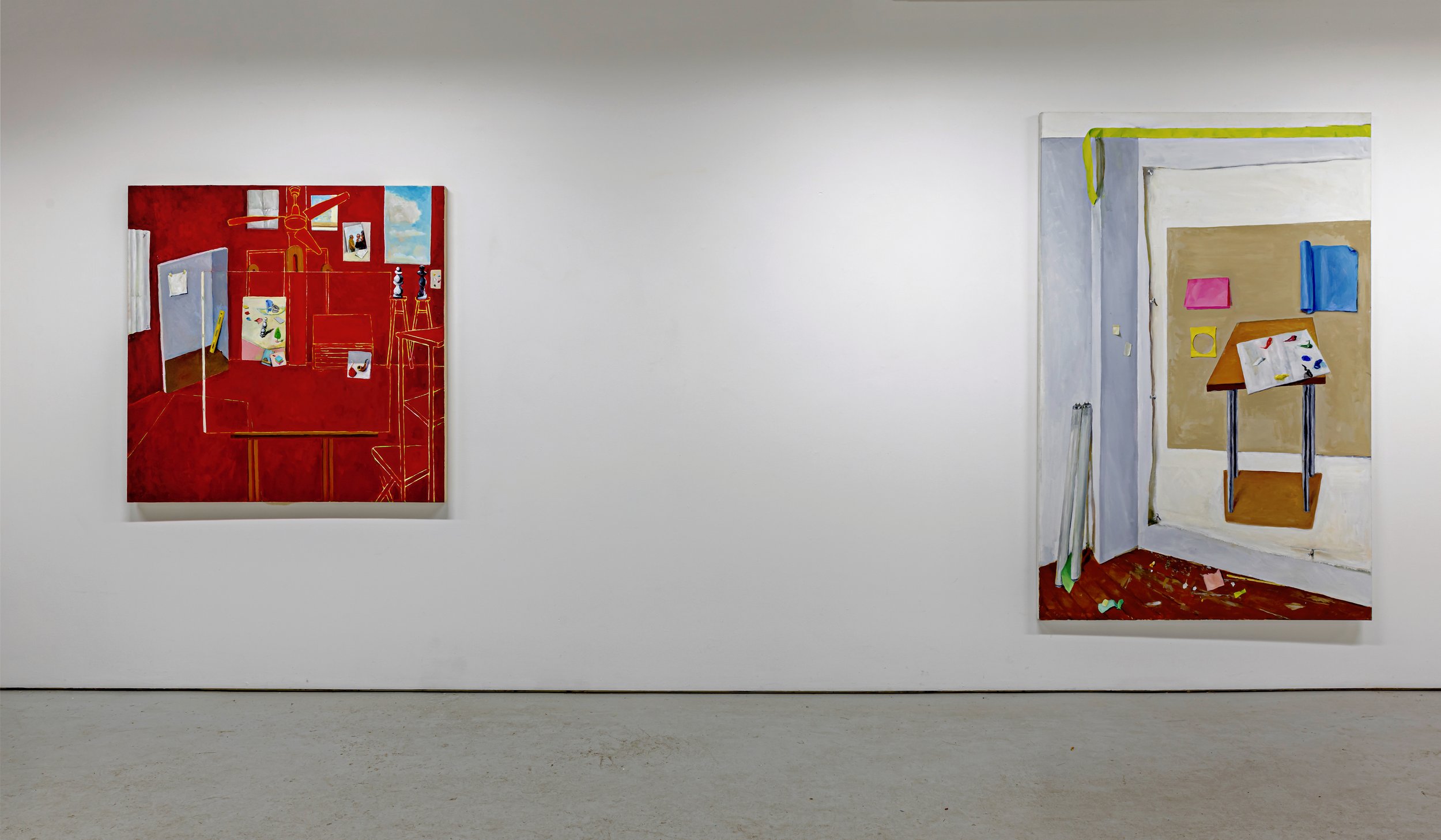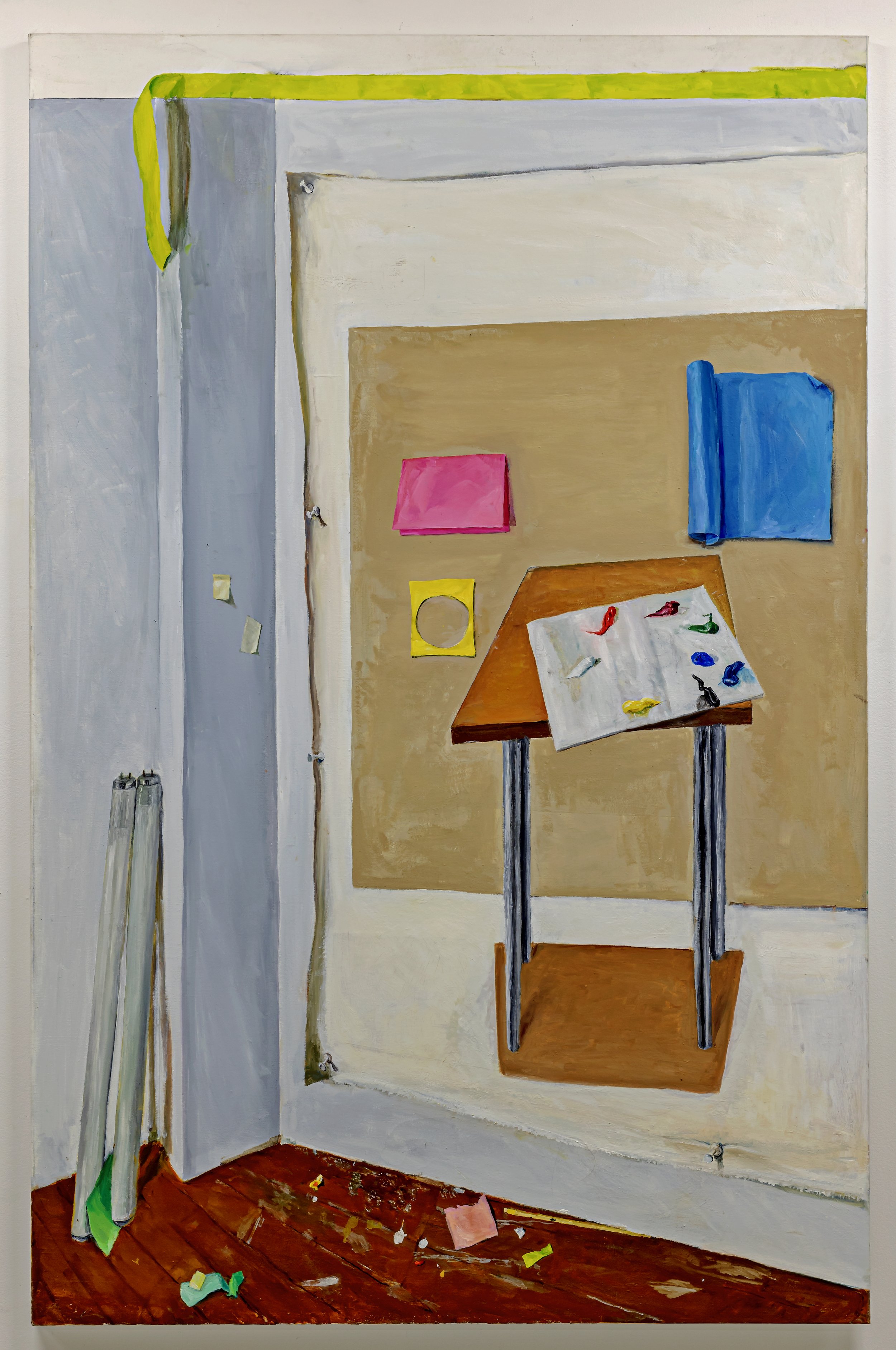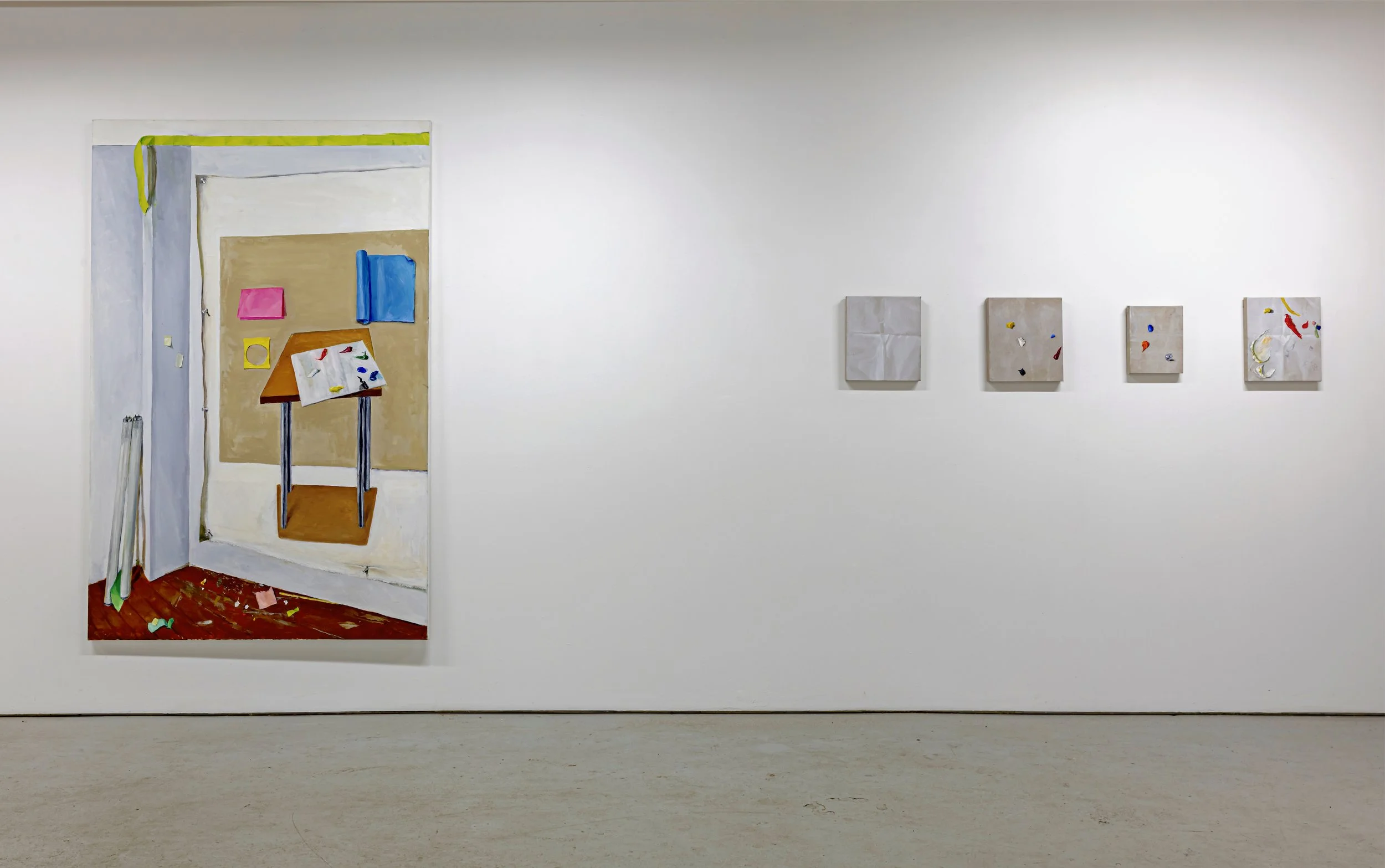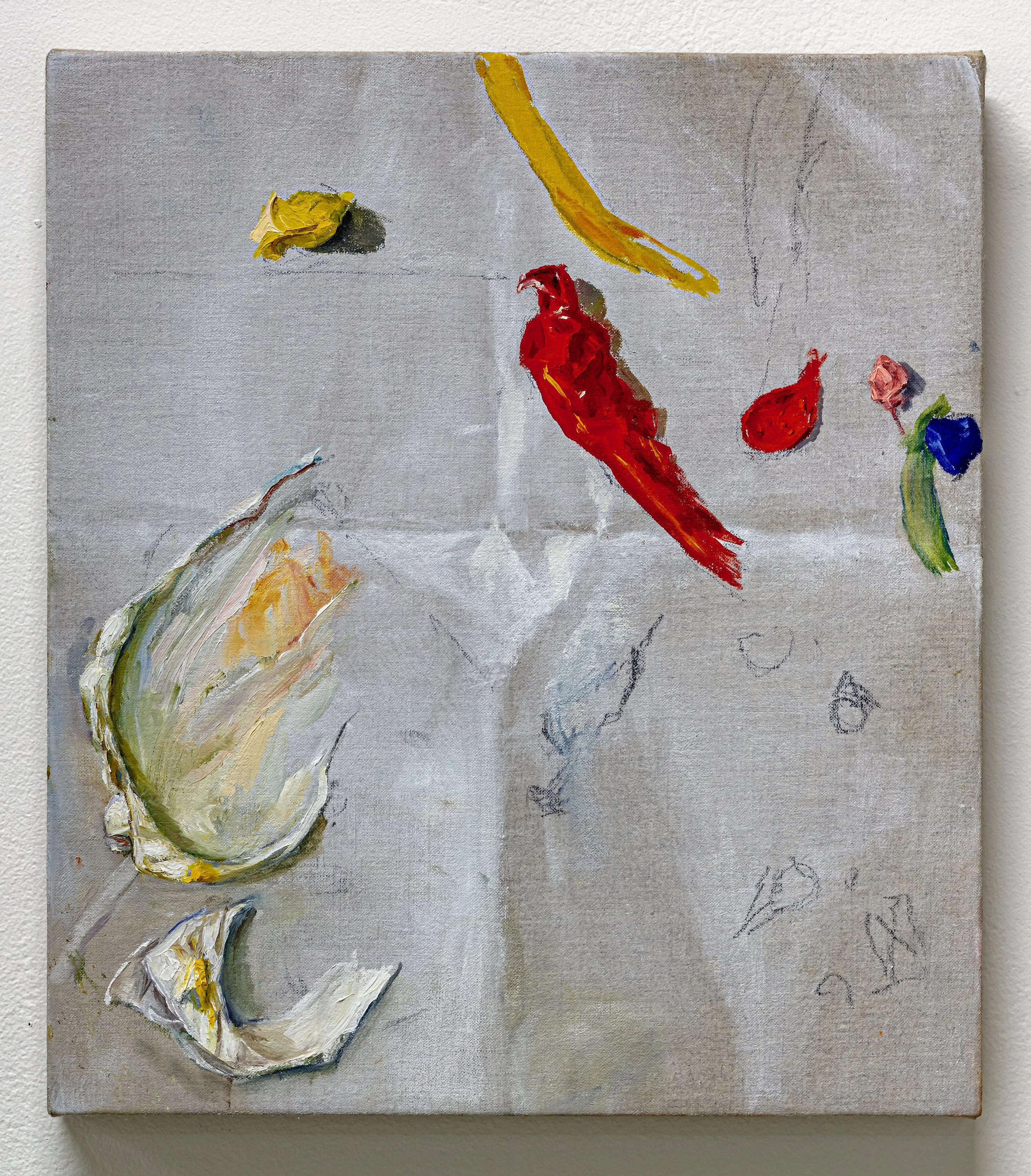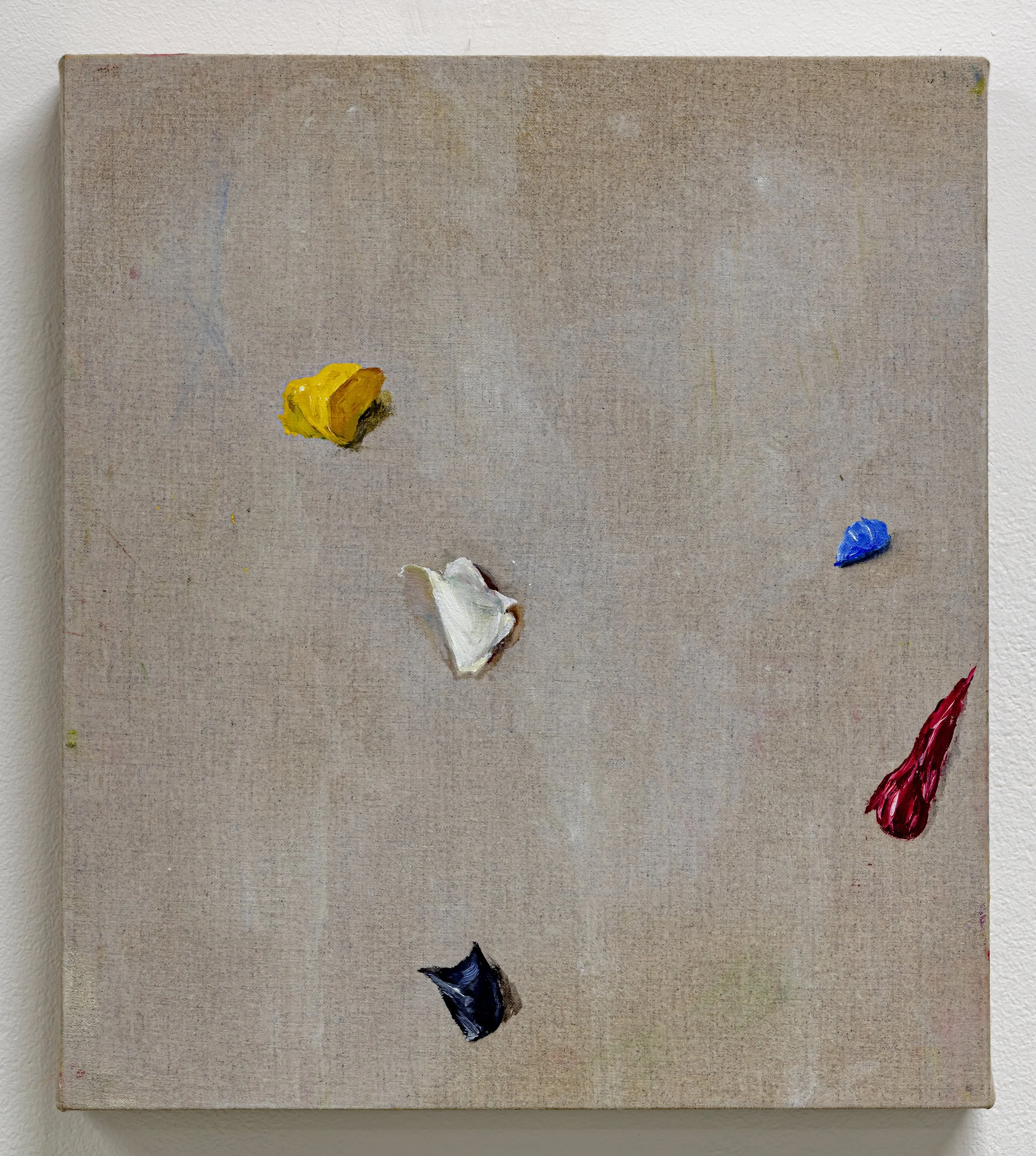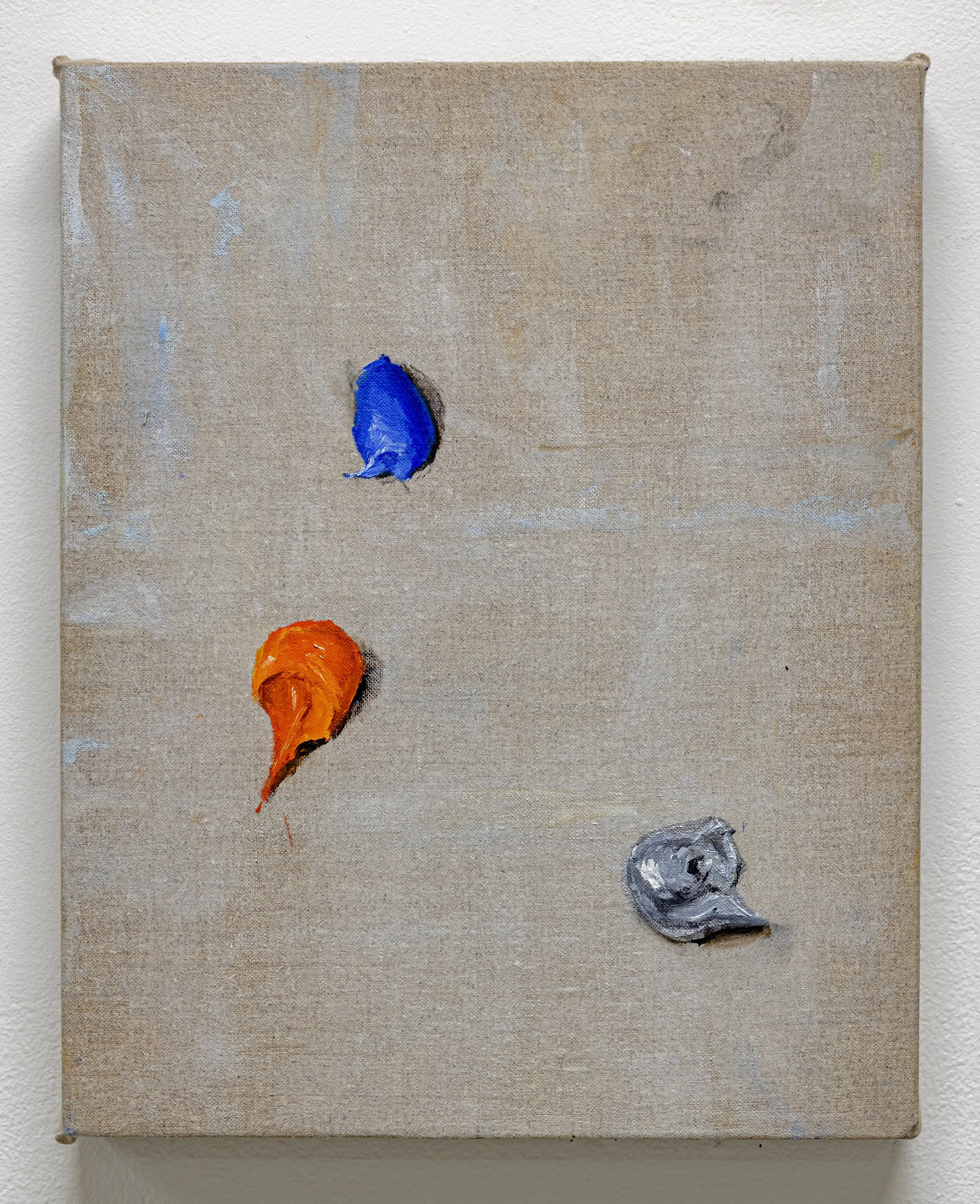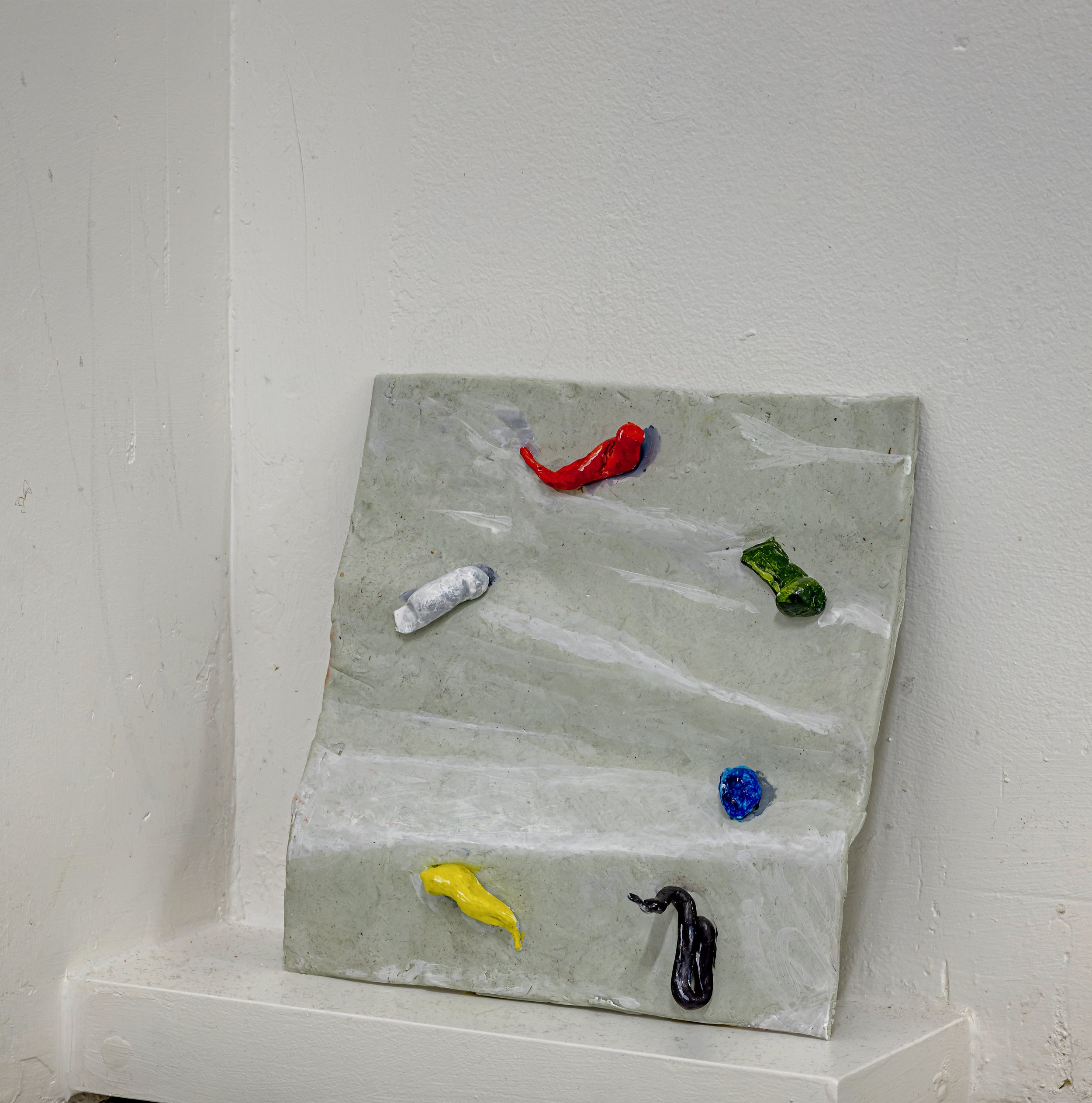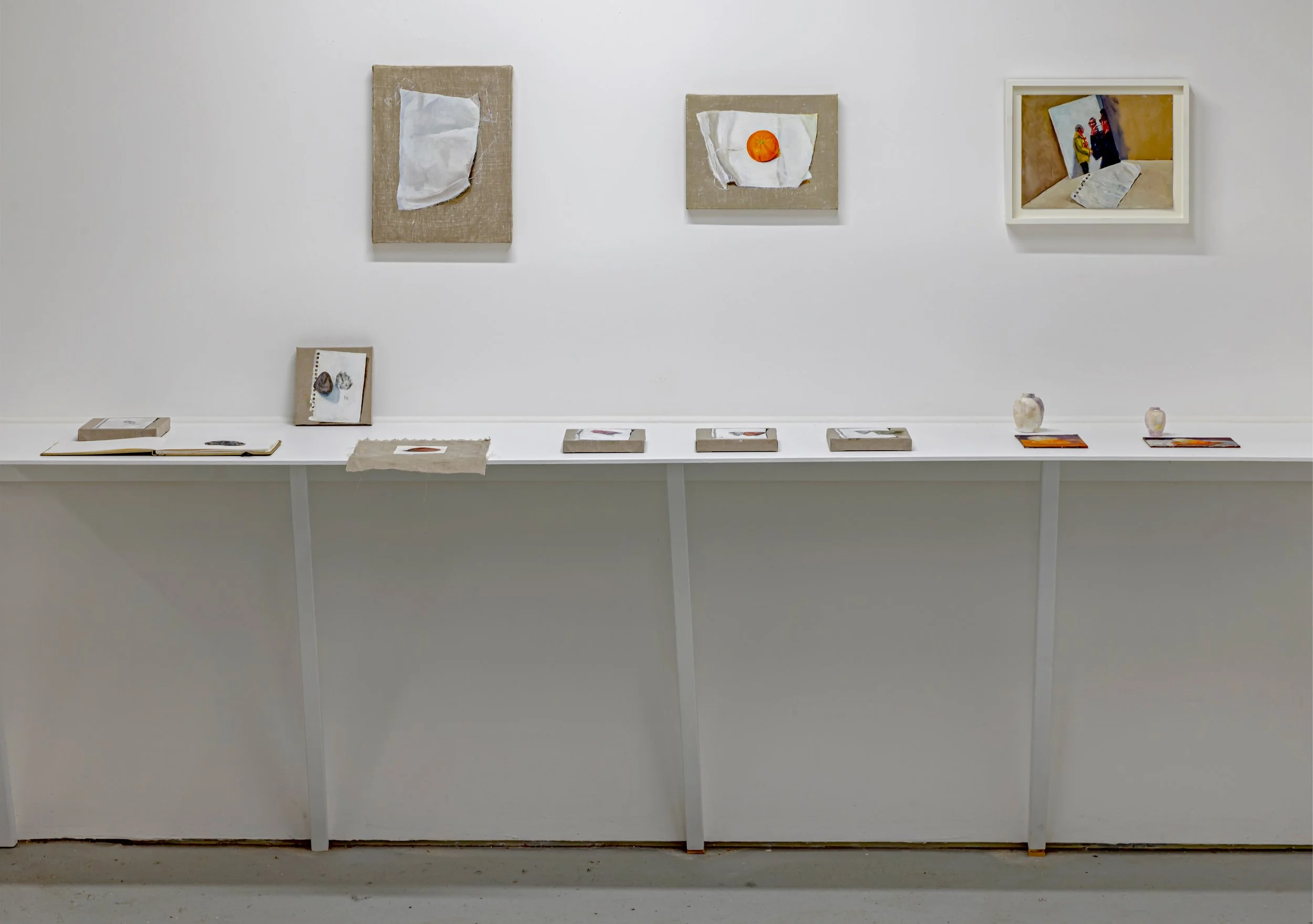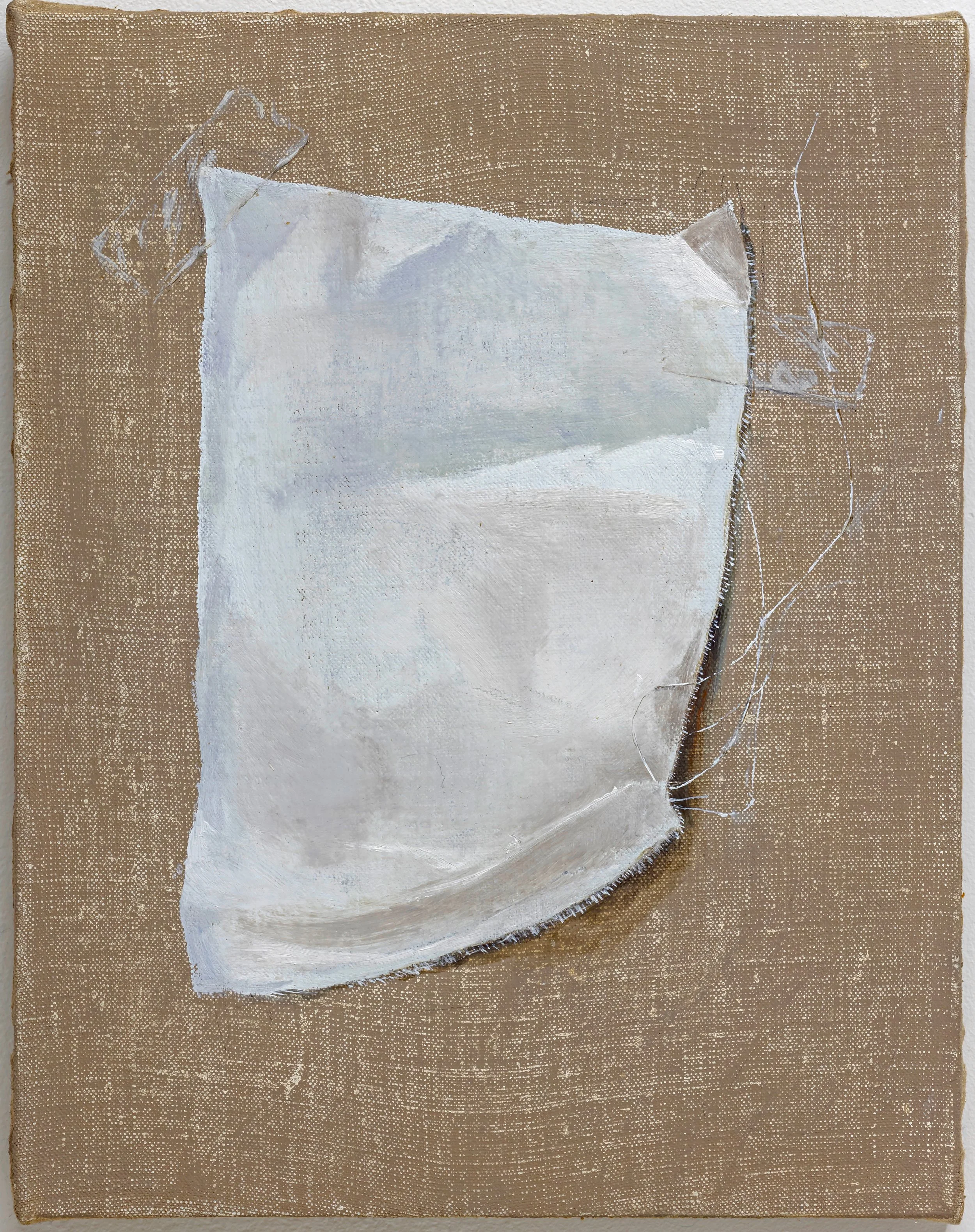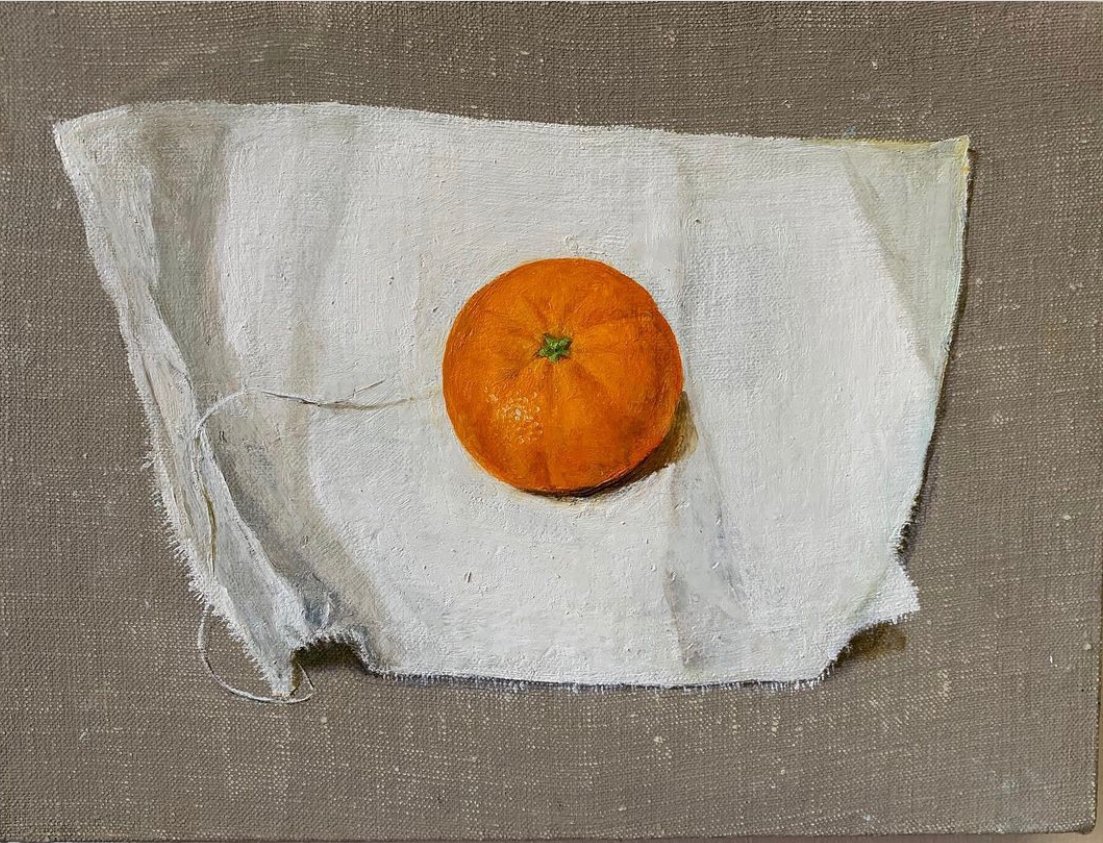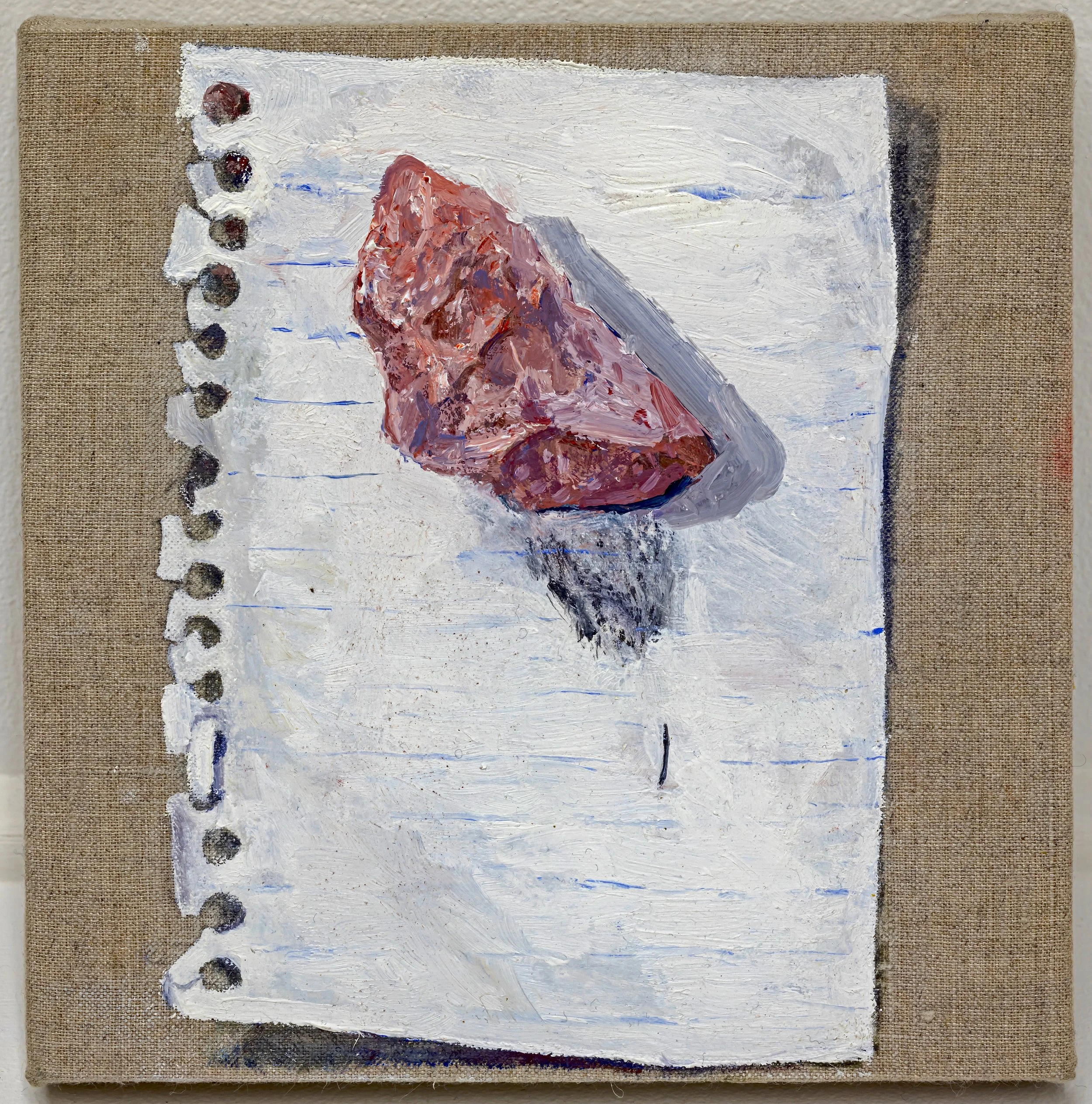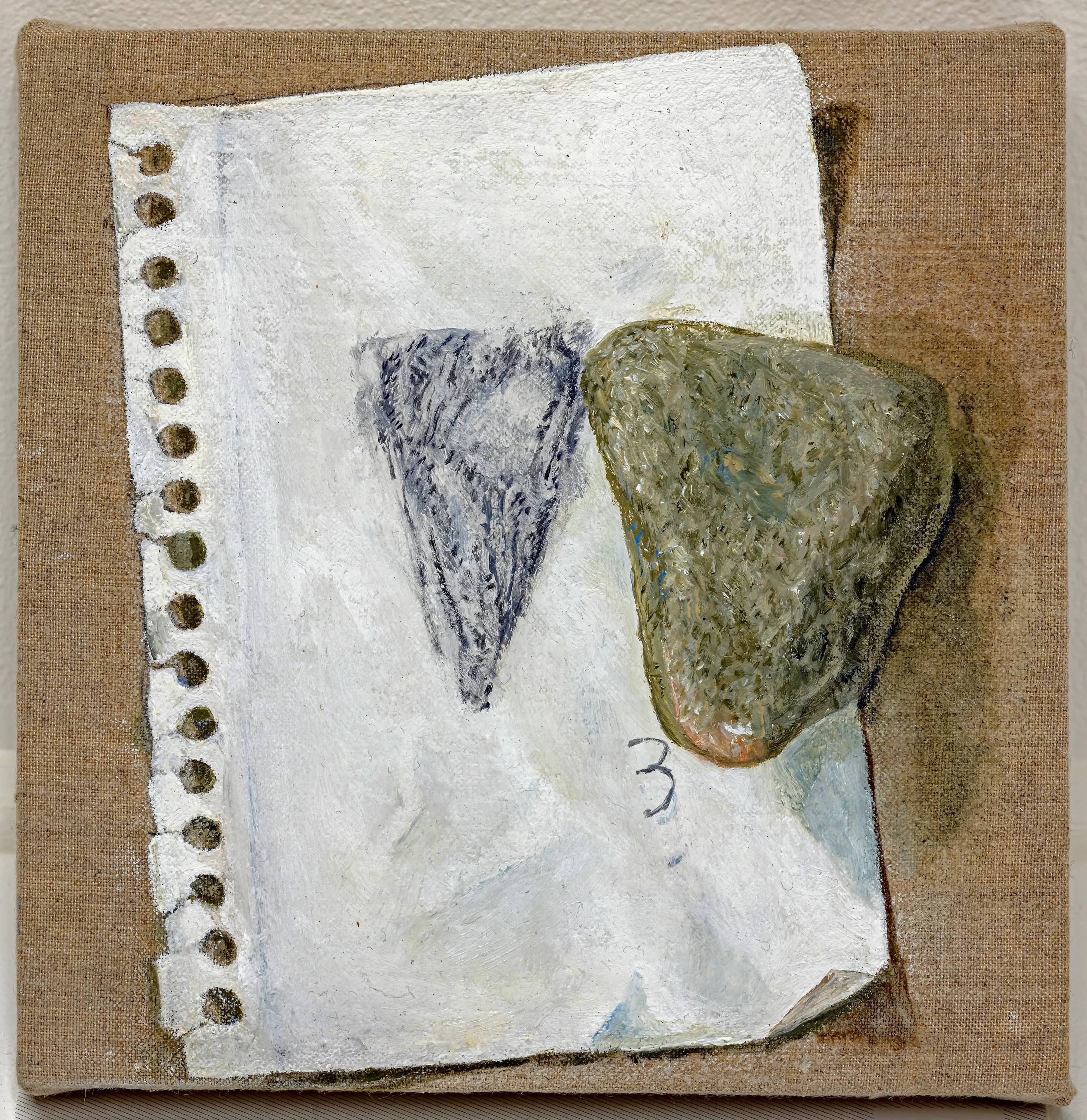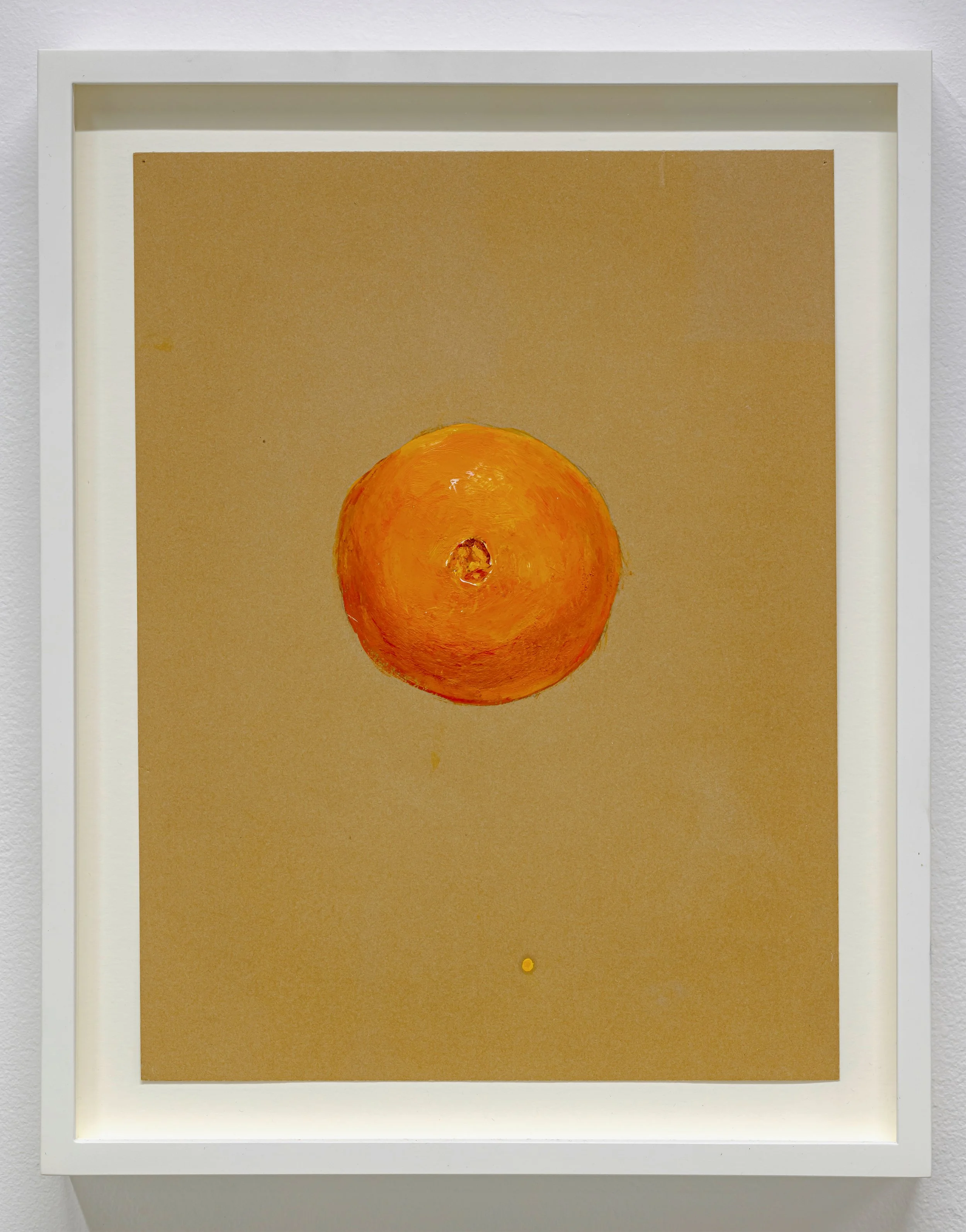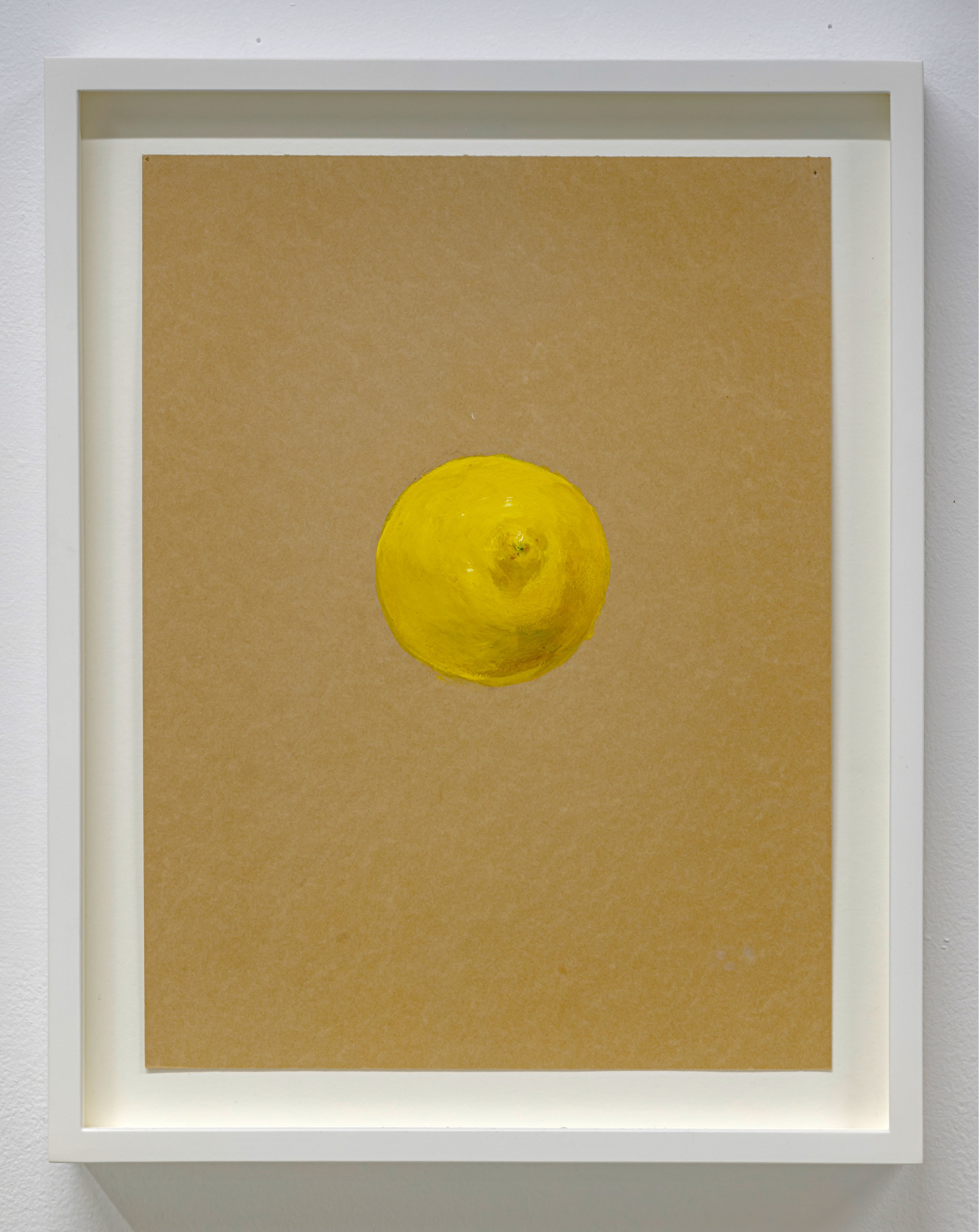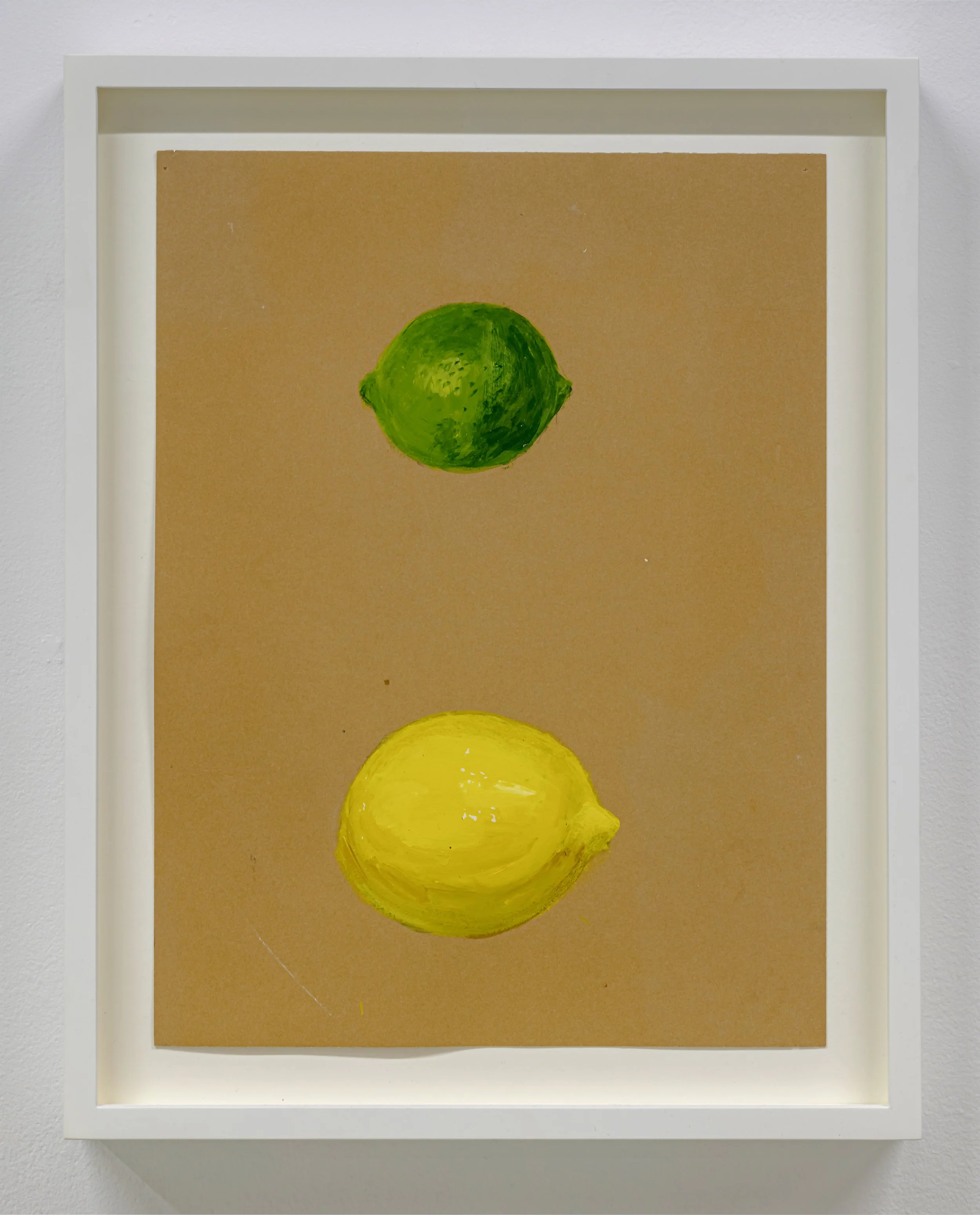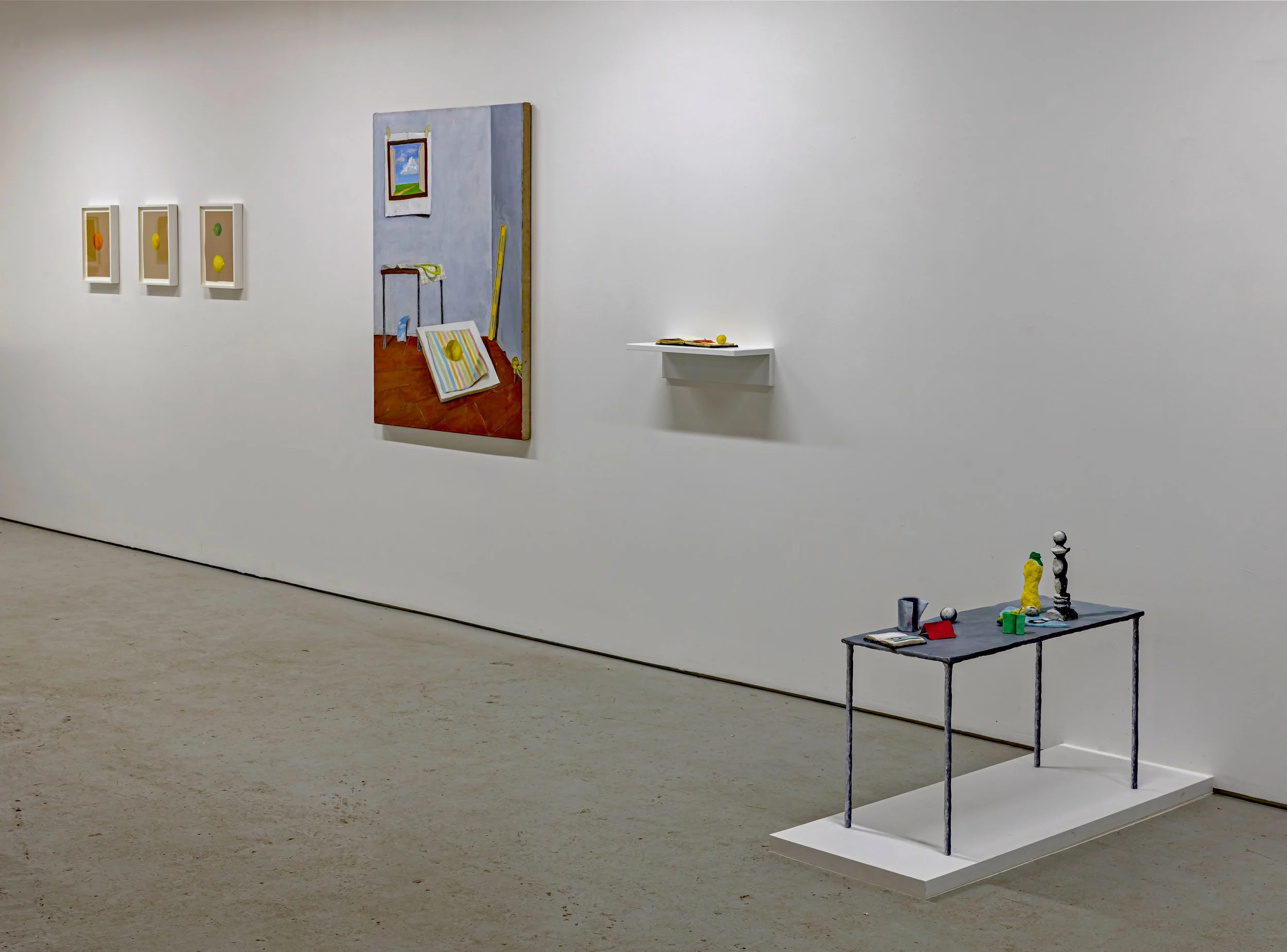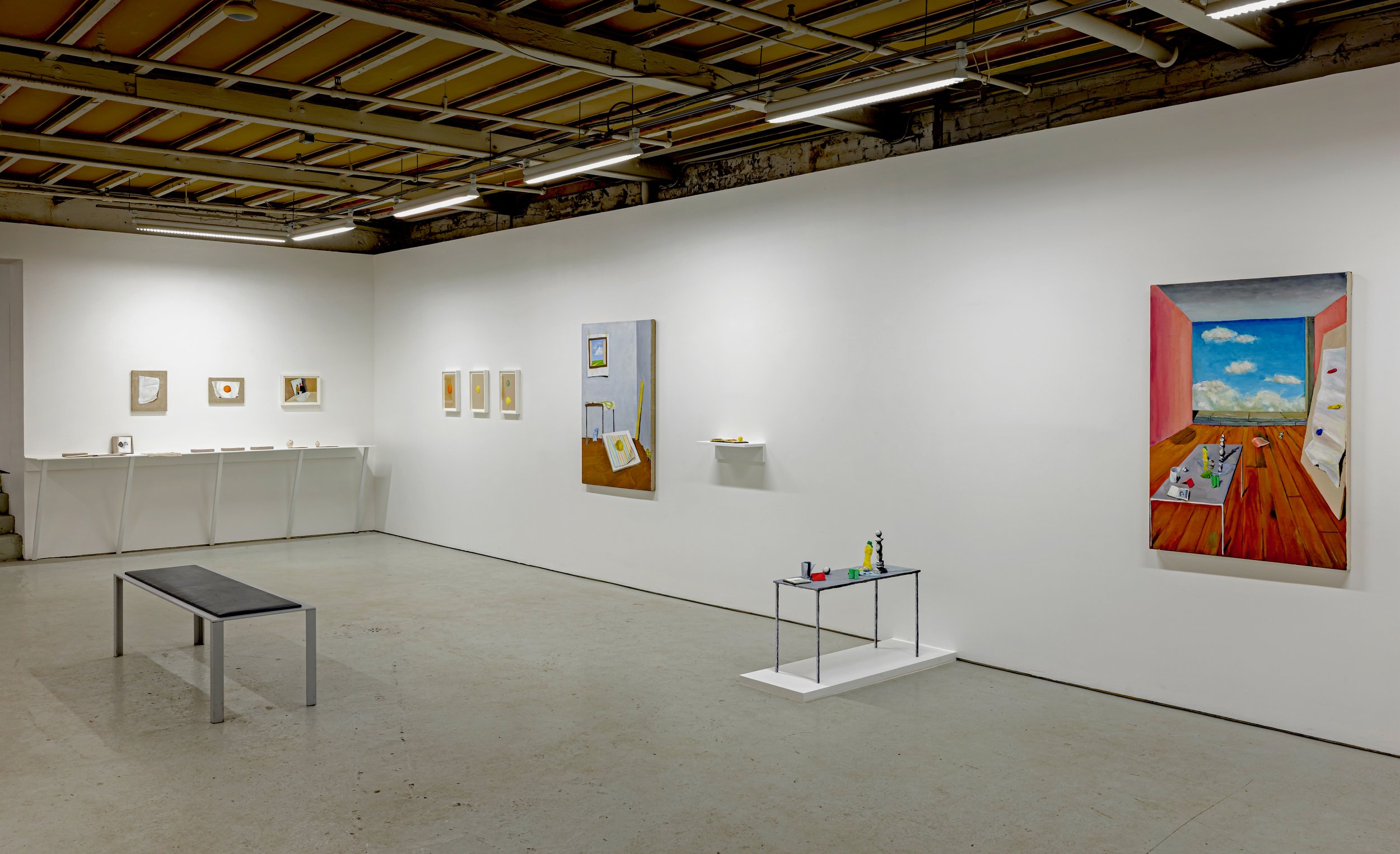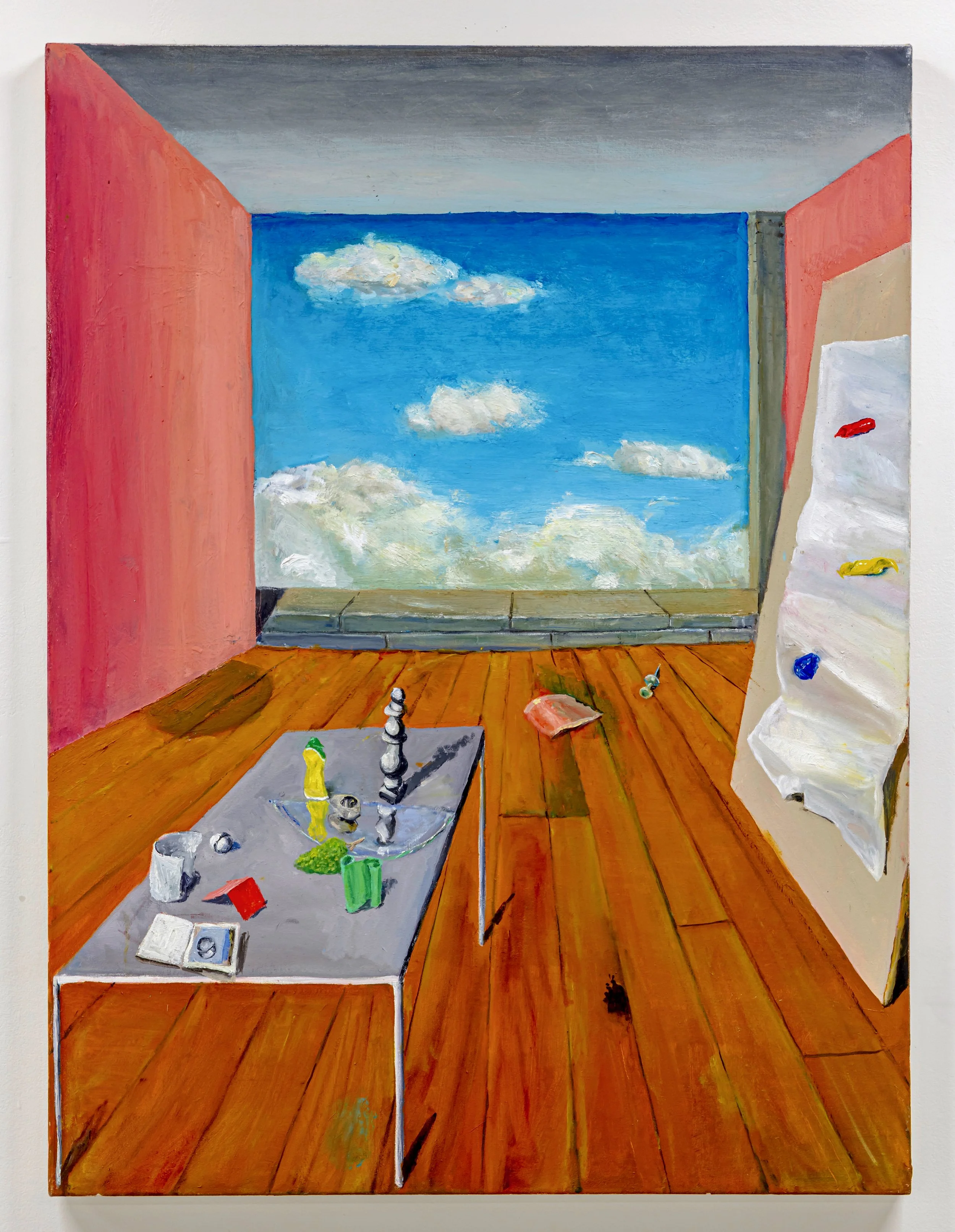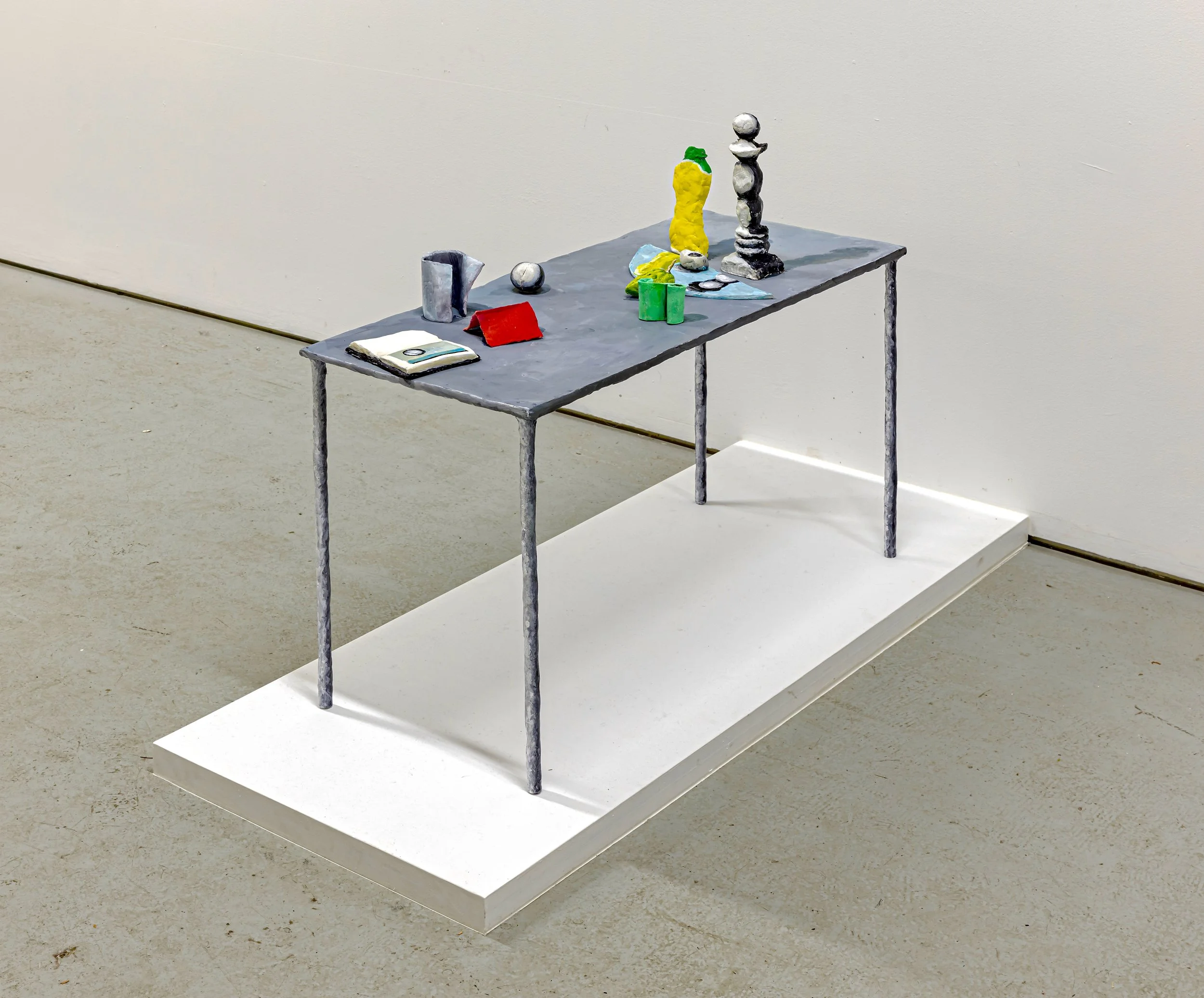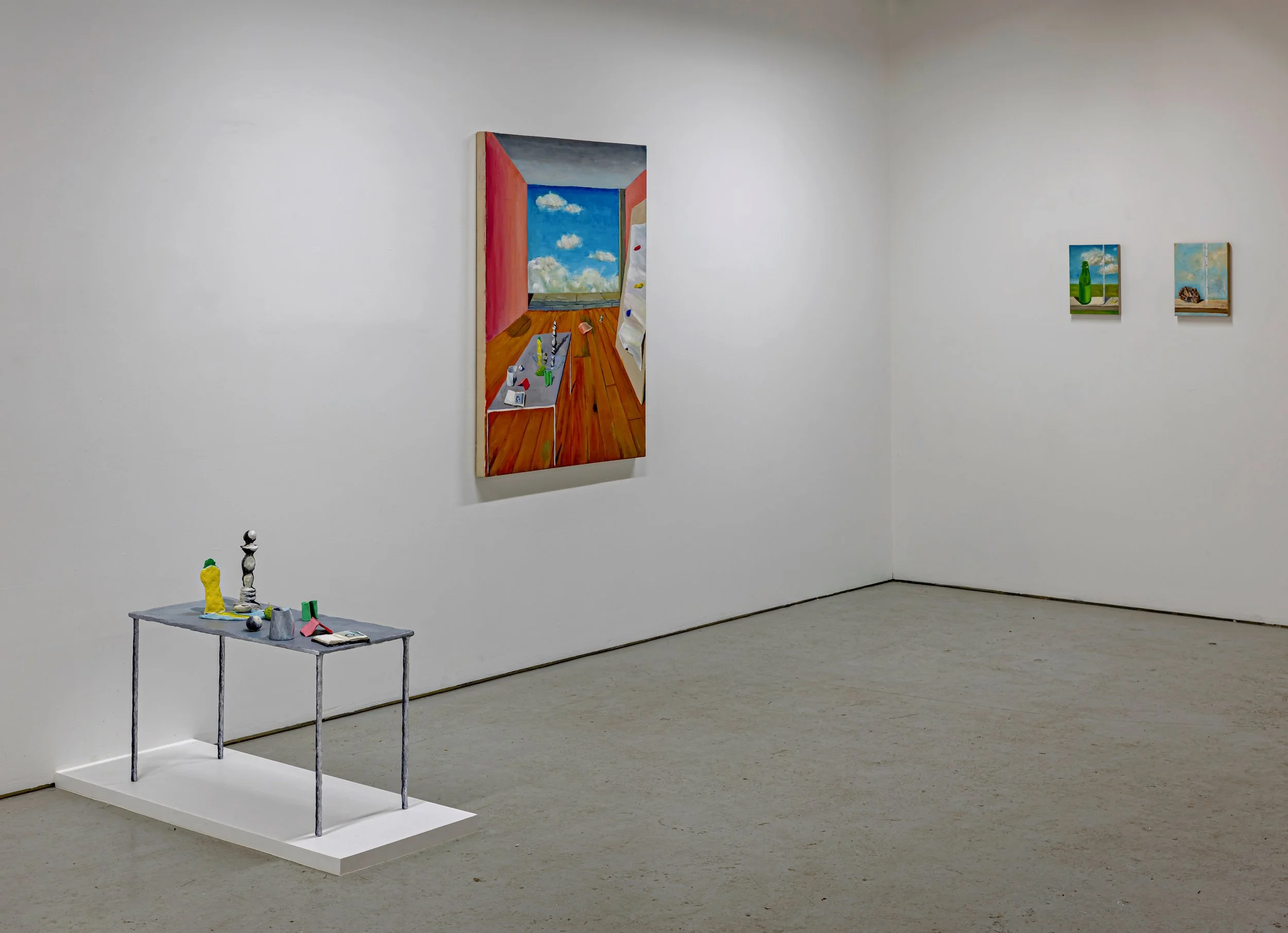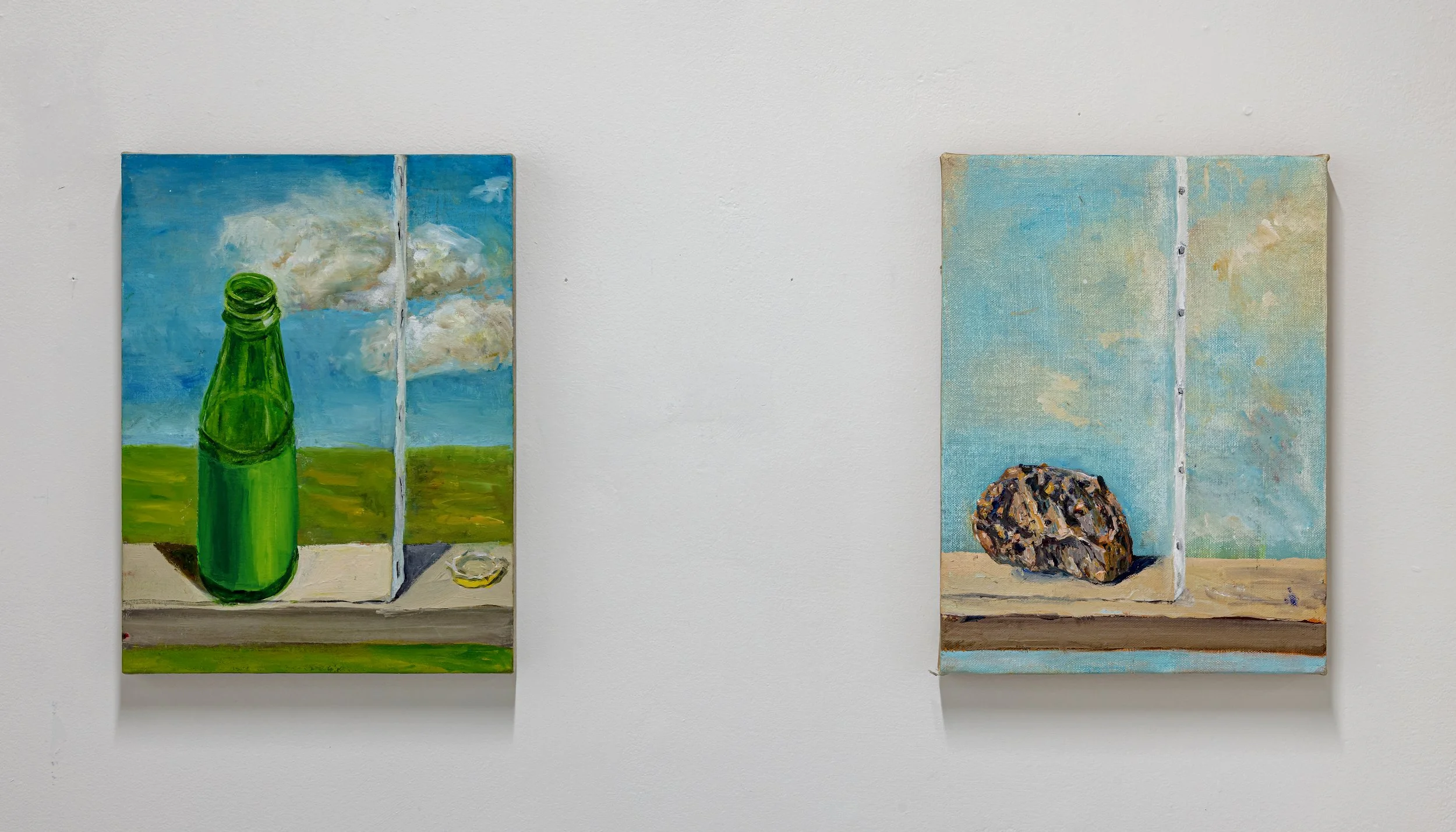From the essay by curator, E.C. Woodley: “Podeswa’s surrealism, like Magritte’s work that he directly references, is full of the confusions, or perhaps, the realities, of representational painting when it is committed to at the highest level. These confusions might be said to be of art in general, including literature and poetry, theatre and film. How to present to another human being the truths that fiction can convey? Perhaps, as a legacy of his work with his father, as well as his recognition of the loss of material and embodied qualities to surface values when viewing artworks online, Podeswa often retains an acute sensitivity for the real … Work such as this which involves itself in embodied existential complexity must be experienced by a viewer present amidst the space of an exhibition in a state of open and contemplative looking." - E.C. Woodley, 2022.
Red Studio, 401 Richmond St., 2022. Oil on canvas, 48” x 48” (Courtesy Birch Contemporary Gallery. Photo: Toni Hafkenscheid)
North wall (installation) (Courtesy Birch Contemporary Gallery. Photo: Toni Hafkenscheid)
Studio with Green Tape, 2021. Oil on canvas, 77 ¼” x 50 1/8” (Courtesy Birch Contemporary Gallery. Photo: Toni Hafkenscheid)
North wall continued (installation) (Courtesy Birch Contemporary Gallery. Photo: Toni Hafkenscheid)
Disposable Palette 1, 2021. Oil on linen, 12 5/8” x 11 1/8” (Courtesy Birch Contemporary Gallery. Photo: Toni Hafkenscheid)
Disposable Palette 1 with Paint, 2021. Oil on linen, 12 5/8” x 11 1/8” (Courtesy Birch Contemporary Gallery. Photo: Toni Hafkenscheid)
Disposable Palette 2 with Paint. Oil on linen, 2021. 12 5/8” x 11 1/8” (Courtesy Birch Contemporary Gallery. Photo: Toni Hafkenscheid)
Disposable Palette 3 with Paint, 2021. Oil on linen, 10 1/8” x 8 1/8” (Courtesy Birch Contemporary Gallery. Photo: Toni Hafkenscheid)
Disposable Palette, 2022. Acrylic, clay (Courtesy Birch Contemporary Gallery. Photo: Toni Hafkenscheid)
Shelf (installation east wall). (Courtesy Birch Contemporary Gallery. Photo: Toni Hafkenscheid)
Crumpled Fabric Taped to Linen, 2020. Oil on linen, 14”x11” (Courtesy Birch Contemporary Gallery. Photo: Toni Hafkenscheid)
Stone (Notebook), 2020. Acrylic on paper (installed on left) (Courtesy Birch Contemporary Gallery. Photo: Toni Hafkenscheid)
Stone (Unstretched Linen), 2002, oil on unstretched linen, 10”x10” (Courtesy Birch Contemporary Gallery. Photo: Toni Hafkenscheid)
Stone,Frottage 1-3 (installed) (Courtesy Birch Contemporary Gallery. Photo: Toni Hafkenscheid)
Frottage on Spiral Notebook Paper 1, 2020. Oil on linen, 6”x6” (Courtesy Birch Contemporary Gallery. Photo: Toni Hafkenscheid)
Stone, Frottage on Spiral Notebook Paper 1, 2020. Oil on linen, 6”x6” (Courtesy Birch Contemporary Gallery. Photo: Toni Hafkenscheid)
Stone, Frottage on Spiral Notebook Paper 2, 2020. Oil on linen, 6”x6” (Courtesy Birch Contemporary Gallery. Photo: Toni Hafkenscheid)
Stone, Frottage on Spiral Notebook Paper 3, 2020. Oil on linen, 6”x6” (Courtesy Birch Contemporary Gallery. Photo: Toni Hafkenscheid)
Stone, Frottage on Spiral Notebook Paper 4, 2020. Oil on linen, 6”x6” (Courtesy Birch Contemporary Gallery. Photo: Toni Hafkenscheid)
My Father, My Brother and Me + My Father’s Still Life with My Painted Sculpture 1 and 2 (installation), 2022 Yidel Podeswa, 2008, Howard Podeswa, 2022 (Courtesy Birch Contemporary Gallery. Photo: Toni Hafkenscheid)
My Father, My Brother, and Me at Wynick/Tuck, 2022. Oil on paper (framed), 9”x 12” (Courtesy Birch Contemporary Gallery. Photo: Toni Hafkenscheid)
My Father’s Still Life with My Painted Sculpture 1 and 2 (installation), 2022 Yidel Podeswa, 2008, Howard Podeswa, 2022 (Courtesy Birch Contemporary Gallery. Photo: Toni Hafkenscheid)
Corner east and south walls (installation) (Courtesy Birch Contemporary Gallery. Photo: Toni Hafkenscheid)
Navel Orange, 2018. Oil on paper, 12” x 9” (Courtesy Birch Contemporary Gallery. Photo: Toni Hafkenscheid)
Lemon, 2018. Oil on paper, 12” x 9” (Courtesy Birch Contemporary Gallery. Photo: Toni Hafkenscheid)
Lemon and Lime, 2018. Oil on paper, 12” x 9” (Courtesy Birch Contemporary Gallery. Photo: Toni Hafkenscheid)
South wall (installation)
Studio with Lemon, 2021. Oil on canvas, 48” x 36” (Courtesy Birch Contemporary Gallery. Photo: Toni Hafkenscheid)
South wall continued (installation) (Courtesy Birch Contemporary Gallery. Photo: Toni Hafkenscheid)
Sketch with Lemon, 2005/2022. Mixed media, 3 ¾” x 11 ¼” x 1 ¾” (Courtesy Birch Contemporary Gallery. Photo: Toni Hafkenscheid)
South and east walls (installation) (Courtesy Birch Contemporary Gallery. Photo: Toni Hafkenscheid)
The Difficult Crossing, 401 Richmond St (After Magritte), 2022. Oil on canvas, 48” x 36” (Courtesy Birch Contemporary Gallery. Photo: Toni Hafkenscheid)
Still Life with Table, 2022. Acrylic, clay. (Courtesy Birch Contemporary Gallery. Photo: Toni Hafkenscheid)
Still Life with Table (detail) (Courtesy Birch Contemporary Gallery. Photo: Toni Hafkenscheid)
South and west walls (installation) (Courtesy Birch Contemporary Gallery. Photo: Toni Hafkenscheid)
West wall (installation) (Courtesy Birch Contemporary Gallery. Photo: Toni Hafkenscheid)
Untitled (Bottle), 2022. Oil on linen, 12” x 9” (Courtesy Birch Contemporary Gallery. Photo: Toni Hafkenscheid)
Untitled (Stone), 2022. Oil on linen, 12” x 9” (Courtesy Birch Contemporary Gallery. Photo: Toni Hafkenscheid)
Dépaysement | Studio
Curatorial Essay by E.C. Woodley:
With Dépaysement | Studio Howard Podeswa extends his thirty-seven-year exploration of the possibilities of representational painting to include forms of surrealism and still life sculpture.
Podeswa also continues to pursue modes of heightened realism begun in his previous exhibition at the gallery, Still Life with Paper which was based on illustrations of geometric colored-paper constructions published in 1929 and designed to teach children how to work with pastel. The act of ‘looking hard at what you see’ had taken on new urgency for Podeswa when his father, Yidel Podeswa (1926–2012) known primarily for his small, still life oil paintings, gave him painting lessons for the first time. His father offered Podeswa a lifetime of methods and recipes, and he in turn responded with a more precise transcription of his subjects.
In Dépaysement | Studio, accompanying two small Yidel Podeswa panels of nectarines and a vase are Podeswa’s small painted clay sculptures of that same vase copied not from life as his father had done, but from his father’s depictions of it. These sculptures sit beside his father’s panels less like vases than urns. Everywhere in the exhibition is an engagement with the fundamental qualities of artmaking: the transmutational qualities of material, and the transformational qualities of the artist’s mind and memory.
At times, elements depicted in Podeswa’s own paintings emerge into the room to become the painted clay sculptures that Podeswa considers to be three-dimensional paintings. A stone vividly painted on a piece of unstretched linen reappears at the other end of the exhibition space as a page painted on a clay sculpture notebook. This notebook sits on a sculptural version of a modernist table along with other painted clay objects, all of which can be found in two dimensions within a gently surrealist painting hung nearby. Representations of stones (it is traditional Jewish practice to leave a small stone at the grave of a loved one) and fruits, the most often depicted subject in his father’s oeuvre reoccur throughout the exhibition.
A few of Podeswa’s small painted sculptures are modeled after the paper constructions that he used to paint Still Life with Paper and some of the others come from objects in Réne Magritte’s paintings. Magritte’s work, quiet and intense in its surrealism, and his notion of dépaysement – “displacement” – is an important element in the exhibition. A surrealist sense of “home” which is also “not home” appears in large paintings of Podeswa’s studio in Toronto. A studio is a home that a painter lives in perhaps more than any other. Where does the contemporary sense of the studio as place of dépaysement come from? The strangeness that the last three years of the COVID-19 crisis has imparted to our private environments is one source. Another source is the very real threat of political oppression as seen in the rise of right-wing governments. When this instability occurred in the 1930’s, it fed into many painting practices across the globe. Surrealism has the capacity to bring politics inward – where politics originate – and where its pressures always live.
Podeswa’s surrealism, like Magritte’s work that he directly references, is full of the confusions, or perhaps, the realities, of representational painting when it is committed to at the highest level. These confusions might be said to be of art in general, including literature and poetry, theatre and film. How to present to another human being the truths that fiction can convey? Perhaps, as a legacy of his work with his father, as well as his recognition of the loss of material and embodied qualities to surface values when viewing artworks online, Podeswa often retains an acute sensitivity for the real. One of many instances of this is the fragile, hanging strip of a contemporary-toxic shade of green-yellow paper tape in one of his studio paintings. Weathered and delicate, it casts a real-seeming shadow. Real and yet always cast, always fixed in place like the materials that form it. Work such as this which involves itself in embodied existential complexity must be experienced by a viewer present amidst the space of an exhibition in a state of open and contemplative looking. - E.C. Woodley, 2022.

